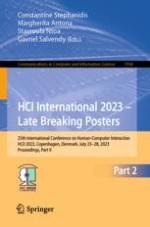This two-volme set CCIS 1957-1958 is part of the refereed proceedings of the 25th International Conference on Human-Computer Interaction, HCII 2023, which was held in Copenhagen, Denmark, in July 2023.
A total of 5583 individuals from academia, research institutes, industry, and governmental agencies from 88 countries submitted contributions, and 1276 papers and 275 posters were included in the proceedings that were published just before the start of the conference. Additionally, 296 papers and 181 posters are included in the volumes of the proceedings published after the conference, as “Late Breaking Work” (papers and posters). The contributions thoroughly cover the entire field of human-computer interaction, addressing major advances in knowledge and effective use of computers in a variety of application areas.
